Prototype Observation of Flow Characteristics in an Inclined-Tube Settling Tank for Fine Sandy Water Treatment
Abstract
:Featured Application
Abstract
1. Introduction
- (1)
- ADV was used to measure the flow field in the inclined-tube settling tank, and the distribution of the dimensionless turbulence intensity and dimensionless Reynolds shear stress in the tank was further analyzed. On this basis, the influence of the tank structure on the flow movement was analyzed, and the reason for the high settling efficiency of the tank was clarified.
- (2)
- Through detailed investigation of the flow field in the tank, the structures which were bad for the sediment settling in the tank were determined, and some suggestions for the tank’s structural optimization were proposed.
2. Experimental Setup and Procedure
2.1. Configuration of the Inclined-Tube Settling Tank
2.2. Experiment Establishment
2.3. Measurement
2.3.1. Measurement Locations
2.3.2. Measurement Method
2.3.3. Calculation Method of Flow Characteristics
3. Result and Analysis
3.1. Longitudinal Flow Characteristics
- Velocity distribution: The high-velocity flow from the inlet opening striking on the flow adjustment board caused the extremely high velocity u in the lower part of the FAA. Additionally, the high-velocity flow also caused the velocity v-w in the FAA to be in disorder, i.e., there are many differences in the magnitude and direction of flow velocity at different measurement locations in the FAA, and swirling flows were formed, which would affect the structural safety of the tank. Sections 3 and 4 were at the two sides of the flow adjustment board. In Section 3, the direction of the velocity v-w was mainly upward. Section 4 showed a more uniform velocity u, and the velocity v-w was downward. The discharge capacity of the upper part of the flow adjustment board with bigger holes was higher than that of the bottom with smaller holes, so the water flowed into the SSA through the upper part of the board, which indicated that the flow adjustment board could redistribute flow with a high velocity from the inlet. The velocity u in the upper SSA was uniform with a range of −0.005–0.01 m/s (when the direction of the velocity vector component consistent with the positive direction of the corresponding coordinate axis, the velocity value was positive, and vice versa). The velocity v-w was lower than that in the FAA, and it only increased at the rear of the SSA due to the resistance of the baffle, and the uniform velocity was beneficial to the large particles settling in the SSA. The flow velocity in the upper part of the ISA increased compared with that in the SSA (see Figure 4a).
- Longitudinal dimensionless turbulence intensity () distribution: The was high in the FAA and SSA, while low in the ISA. The was uneven in the FAA, which was mainly caused by the backflow caused by the water from the inlet that struck the flow adjustment board. When the water flowed through the board, the velocity would be intensely redistributed in a short time, leading to a violent turbulence of the flow with the value within 16–24%. The turbulence helped to further dissipate the kinetic energy of the flow and decrease the velocity. In the latter half of the SSA, the value gradually decreased to 2–8%, contributing to the adhesion of the viscous sediment particles to form the flocculation of sediment and to the flocs settling in the ISA. The value in the upper part of the ISA was 0–4%. The flow in the inclined tubes was laminar, so the flow pattern was still stable after flowing out of the inclined tubes. The of the latter part of the ISA increased affected by the overflow suction (see Figure 4b).
- Longitudinal dimensionless Reynold shear stress () distribution: This represents the dimensionless Reynolds shear stress in the direction X and normal to Z. The distribution of the was high in the FAA and the SSA, and low in the upper part of the ISA with a range of 0–8% (see Figure 4c). The in the FAA was in the range of 4–8%, and the maximum value appeared in the range of Z = 50–100 cm. The flocculation of sediment in the inclined-tube settling tank mainly appeared in the range of Z = 50–150 cm, so the moderately increased could further promote the flocculation of sediment and accelerate its settling.
3.2. Transverse Flow Characteristics
- Velocity distribution: In the FAA, the velocity v near the side wall was high, which showed that there were vortexes along the Y direction at the bottom of this area. The vortexes could wash away the sediment that had been deposited at the bottom of the tank and made it suspend in the flow, reducing the settling efficiency. Because the baffle blocked the upper flow movement, the velocity in the SSA was very slow, with a range of −0.002–0.002 m/s. It was only within Z = 0–50 cm that the velocity was higher. In the ISA, the section of Y = 20 cm was far away from the overflow weir, so the suction effect was not obvious, and the velocity v was less than 0.002 m/s. However, with the decrease of the distance from the overflow weir, the velocity v increased. The direction of the velocity u-w was downward at the front part of the ISA, indicating a downward movement of the flow in the inclined tubes at the front part of the ISA, while it was upward at the latter part of the area, affected by the overflow suction. (see Figure 5a).
- Transverse dimensionless turbulence intensity distribution: The gradually increased from the right wall of the tank to the left (the overflow side) (see Figure 5b). The block effect of the baffle on the middle and upper part of the flow led to the in the middle and the upper part being higher than that in the lower part. At the same time, the in the ISA was also significantly higher than that in other areas, indicating that the velocity v of the flow fluctuated greatly and directly related to the suction of the overflow weir.
- Transverse dimensionless Reynold shear stress distribution: represents the Reynolds shear stress in the direction Y and normal to X. The distribution of each section was similar, ranging from 0 to 4%. The maximum value of mainly appeared in the FAA and the front part of the SSA (behind the flow adjustment board) (see Figure 5c). The distribution of in the whole flow field of the tank was low, and its influence on the sedimentation was not obvious.
3.3. Vertical Flow Characteristics
- Velocity distribution: The distribution of the velocity w in the middle and lower part of the tank was similar. The flow velocity changed sharply in the FAA and the front and the back of the flow adjustment board, while it was uniform in the SSA. Affected by the friction of the tank bottom, the velocity u-v near the bottom was low and only significantly increased near the baffle. Influenced by the high-velocity flow from the inlet, when Z = 40 cm, the velocity u-v in the FAA was extremely high. After the water flowed through the flow adjustment board, the velocity u-v significantly reduced, but it was still higher than others at other heights which were not beneficial to the sediment settling, which was caused by the water flowing into the ISA through the gap between the baffle and the tank bottom. In the ISA, because the tubes blocked the longitudinal movement of the middle and lower part of the flow, the surface flow velocity u-v was high. In the latter half of the area, affected by the suction effect of the overflow weir, the direction of the velocity u-v was gradually biased toward the left side of the tank (i.e., the side of the overflow weir), indicating the great influence of the overflow weir on the flow pattern in the tank (see Figure 6a).
- Vertical dimensionless turbulence intensity distribution: The distribution of the was low at the bottom and the upper part of the tank and high in the middle part (see Figure 6b). In the three dimensions, the was the lowest. The lower turbulence intensity was favorable for the collision and adhesion of the viscous sediment particles and the formation of the floc. It also helped to speed up sediment settling at the tank bottom in a shorter time.
- Vertical dimensionless Reynold shear stress () distribution: represents the dimensionless Reynolds shear stress in the direction Z and normal to Y, within a range of 0–12% (see Figure 6c). The distribution was high in the FAA and the lower part of the SSA, and the decreased with the decrease of the water depth. This might because of the high flow velocity at the tank bottom while the low velocity in the upper part. The ranged from 6% to 12% in the upper part of the ISA, which was the result of the high upward velocity of the water flowing out of the inclined tubes.
4. Discussion
5. Conclusions
- (1)
- After flowing through the flow adjustment board, the flow velocity decreased from 0.03 m/s to −0.005–0.01 m/s, indicating that the flow pattern in the inclined-tube settling tank could be significantly improved by the flow adjustment board. The flow pattern in the upper ISA was steady, with a range of 0–0.008 m/s, indicating that the inclined tubes could improve the flow pattern. The water inlet, baffle and the overflow weir in the tank negatively affected the flow pattern of the tank.
- (2)
- The dimensionless turbulence intensity and dimensionless Reynolds shear stress of the flow in the inclined-tube settling tank changed sharply in the FAA, near the flow adjustment board, baffle and the overflow weir, while they were uniformly distributed in other areas. Under the conditions in this paper, the turbulence intensity and Reynolds shear stress of the flow in the tank were conductive to the collision of the sediment particles and floc formation, accelerating the settling velocity in the water.
Author Contributions
Funding
Acknowledgments
Conflicts of Interest
References
- Zhang, J.; Shi, K.; Gao, Y.; Wang, J. Turbid water desilting characteristics of circular-ring desilting and sediment ejection basin. Trans. Chin. Soc. Agric. Eng. 2014, 30, 86–93. [Google Scholar]
- Juan, S. Design of gravity desilting filter tank for drip irrigation with river water and its extension. Water Sav. Irrig. 2014, 1, 60–64. [Google Scholar]
- He, C.; Scott, E.; Rochfort, Q. Enhancing sedimentation by improving flow conditions using parallel retrofit baffles. J. Environ. Manag. 2015, 160, 1–6. [Google Scholar] [CrossRef]
- Bajcar, T.; Gosar, L.; Širok, B.; Steinman, F.; Rak, G. Influence of flow field on sedimentation efficiency in a circular settling tank with peripheral inflow and central effluent. Chem. Eng. Process. Process Intensif. 2010, 49, 514–522. [Google Scholar] [CrossRef]
- Boycott, A.E. Sedimentation of blood corpuscles. Nature 1920, 104, 532. [Google Scholar] [CrossRef]
- Willis, R.M. Tubular settlers—A technical review. J. AWWA 1978, 70, 331–335. [Google Scholar] [CrossRef]
- Galvin, K.P.; Nguyentranlam, G. Influence of parallel inclined plates in a liquid fluidized bed system. Chem. Eng. Sci. 2002, 57, 1231–1234. [Google Scholar] [CrossRef]
- Doroodchi, E.; Zhou, J.; Fletcher, D.F.; Galvin, K.P. Particle size classification in a fluidized bed containing parallel inclined plates. Miner. Eng. 2006, 19, 162–171. [Google Scholar] [CrossRef]
- Laskovski, D.; Duncan, P.; Stevenson, P.; Zhou, J.; Galvin, K.P. Segregation of hydraulically suspended particles in inclined channels. Chem. Eng. Sci. 2006, 61, 7269–7278. [Google Scholar] [CrossRef]
- Han, S.; Li, Y.; Xu, F.; Sun, D.; Feng, J.; Liu, Z.; Wu, R.; Wang, Z. Effect of lateral flushing on emitter clogging under drip irrigation with Yellow River water and a suitable method. Irrig. Drain. 2018, 67, 199–209. [Google Scholar] [CrossRef]
- Li, Q.; Song, P.; Zhou, B.; Xiao, Y.; Muhammad, T.; Liu, Z.; Zhou, H.; Li, Y. Mechanism of intermittent fluctuated water pressure on emitter clogging substances formation in drip irrigation system utilizing high sediment water. Agric. Water Manag. 2019, 215, 16–24. [Google Scholar] [CrossRef]
- Bandrowski, J.; Hehlmann, J.; Merta, H.; Zioło, J. Studies of sedimentation in settlers with packing. Chem. Eng. Process. Process Intensif. 1997, 36, 219–229. [Google Scholar] [CrossRef]
- Xie, M.; Shi, Z.; Liu, X. The Motion and Removal Efficiency of Particles in Circular Tube Settlers. In Proceedings of the 2009 International Conference on Energy and Environment Technology, Guilin, China, 16–18 October 2009; Volume 1, pp. 437–440. [Google Scholar]
- Ignjatović, L. Efficient (tube) settling tanks. Water Sci. Technol. 1991, 24, 223–228. [Google Scholar] [CrossRef]
- Peker, S.M.; Helvaci, S.S. Solid-Liquid Two Phase Flow; Elsevier: Amsterdam, The Netherlands, 2011. [Google Scholar]
- Casey, T.J.; Casey, T. Unit Treatment Processes in Water and Wastewater Engineering; Wiley Chichester: Hoboken, NJ, USA, 1997; pp. 166–170. [Google Scholar]
- Shahrokhi, M.; Rostami, F.; Said, M.A.M.; Yazdi, S.R.S. The effect of number of baffles on the improvement efficiency of primary sedimentation tanks. Appl. Math. Model. 2012, 36, 3725–3735. [Google Scholar] [CrossRef]
- Stamou, A.; Adams, E.; Rodi, W. Numerical modeling of flow and settling in primary rectangular clarifiers. J. Hydraul. Res. 1989, 27, 665–682. [Google Scholar] [CrossRef]
- Krebs, P.; Vischer, D.; Gujer, W. Inlet-structure design for final clarifiers. J. Environ. Eng. 1995, 121, 558–564. [Google Scholar] [CrossRef]
- Larsen, P. On the Hydraulics of Rectangular Settling Basins: Experimental and Theoretical Studies; Department of Water Resources Engineering, Lund Institute of Technology, University of Lund: Lund, Sweden, 1977. [Google Scholar]
- Mccorquodale, J.A.; Zhou, S. Effects of hydraulic and solids loading on clarifier performance. J. Hydraul. Res. 1993, 31, 461–478. [Google Scholar] [CrossRef]
- Schamber, D.R.; Larock, B.E. Numerical analysis of flow in sedimentation basins. J. Hydraul. Div. 1981, 107, 575–591. [Google Scholar]
- Wang, X.; Yang, L.; Sun, Y.; Song, L.; Zhang, M.; Cao, Y. Three-dimensional simulation on the water flow field and suspended solids concentration in the rectangular sedimentation tank. J. Environ. Eng. 2008, 134, 902–911. [Google Scholar] [CrossRef]
- Ekama, G.; Marais, P. Assessing the applicability of the 1D flux theory to full-scale secondary settling tank design with a 2D hydrodynamic model. Water Res. 2004, 38, 495–506. [Google Scholar] [CrossRef]
- López, P.R.; Lavín, A.G.; López, M.M.M.; Heras, J.L.B.D.L. Flow models for rectangular sedimentation tanks. Chem. Eng. Process. Process Intensif. 2008, 47, 1705–1716. [Google Scholar] [CrossRef]
- Romphophak, P.; Wongwailikhit, K.; Chawaloesphonsiya, N.; Samornkraisorakit, P.; Painmanakul, P. Study of flow pattern in jet clarifier for removal of turbidity by residence time distribution approach. Eng. J. 2016, 20, 17–27. [Google Scholar] [CrossRef] [Green Version]
- Taebi-Harandy, A.; Schroeder, E.D. Analysis of structural features on performance of secondary clarifiers. J. Environ. Eng. 1995, 121, 911–918. [Google Scholar] [CrossRef]
- Younes, M.; Younes, Y.; El-Madah, M.; Ibrahim, I.; El-Dannanh, E. An experimental investigation of hydrodynamic damping due to vertical baffle arrangements in a rectangular tank. J. Eng. Marit. Environ. 2007, 221, 115–123. [Google Scholar] [CrossRef]
- Imam, E.; McCorquodale, J.A.; Bewtra, J. Numerical modeling of sedimentation tanks. J. Hydraul. Eng. 1983, 109, 1740–1754. [Google Scholar] [CrossRef]
- Liu, B.; Ma, J.; Luo, L.; Bai, Y.; Wang, S.; Zhang, J. Two-dimensional LDV measurement, modeling, and optimal design of rectangular primary settling tanks. J. Environ. Eng. 2010, 136, 501–507. [Google Scholar] [CrossRef]
- Razmi, A.; FirouzabadiI, B.; Ahmadi, G. Experimental and numerical approach to enlargement of performance of primary settling tanks. J. Appl. Fluid Mech. 2009, 2, 1–12. [Google Scholar]
- Nikora, V.; Goring, D.G. Flow turbulence over fixed and weakly mobile gravel beds. J. Hydraul. Eng. 2000, 126, 679–690. [Google Scholar] [CrossRef]
- Casonato, M.; Gallerano, F. A finite difference self-Adaptive mesh solution of flow in a sedimentation tank. Int. J. Numer. Methods Fluids 1990, 10, 697–711. [Google Scholar] [CrossRef]
- Maruejouls, T.; Vanrolleghem, P.A.; Pelletier, G.; Lessard, P. A phenomenological retention tank model using settling velocity distributions. Water Res. 2012, 46, 6857–6867. [Google Scholar] [CrossRef]
- Goula, A.M.; Kostoglou, M.; Karapantsios, T.D.; Zouboulis, A.I. A CFD methodology for the design of sedimentation tanks in potable water treatment: Case study: The influence of a feed flow control baffle. Chem. Eng. J. 2008, 140, 110–121. [Google Scholar] [CrossRef]
- Tarpagkou, R.; Pantokratoras, A. CFD methodology for sedimentation tanks: The effect of secondary phase on fluid phase using DPM coupled calculations. Appl. Math. Model. 2013, 37, 3478–3494. [Google Scholar] [CrossRef]
- Abdelgawad, S.M.; Mccorquodale, J.A. Hydrodynamic of circular primary clarifiers. Can. J. Civ. Eng. 1984, 11, 299–307. [Google Scholar] [CrossRef]
- Tarpagkou, R.; Pantokratoras, A. The influence of lamellar settler in sedimentation tanks for potable water treatment—A computational fluid dynamic study. Powder Technol. 2014, 268, 139–149. [Google Scholar] [CrossRef]
- Zhou, S.; Mccorquodale, J.A.; Godo, A.M. Short Circuiting and Density Interface in Primary Clarifiers. J. Hydraul. Eng. 1994, 120, 1060–1080. [Google Scholar] [CrossRef]
- Wu, J.; Zong, Q.; Liu, H.; Liu, C. Experiment study of flow’s adjusting with flow board in sediment basin. J. Water Resour. Water Eng. 2007, 5, 6–9. [Google Scholar]
- Hua, G.; Liu, H. Research on the effect of adjusting flow board on flow of the sand basin for micro-irrigation. China Rural. Water Hydropower 2012, 10, 13–16. [Google Scholar]
- Clay Mcmichael, F. Sedimentation in inclined tubes and its application for the design of high rate sedimentation devices. J. Hydraul. Res. 1972, 10, 59–75. [Google Scholar] [CrossRef]
- Yao, K. Theoretical study of high-rate sedimentation. J. Water Pollut. Control Fed. 1970, 42, 218–228. [Google Scholar]
- Bagnold, R.A.; Nevins, T.H.F. Correspondence. Some flume experiments on large grains but little denser than the transporting fluid, and their implications. Proc. Inst. Civ. Eng. 1955, 4, 1058–1060. [Google Scholar] [CrossRef]
- Bruhl, H.; Kazanskij, I. New results concerning the influence of fine particles on sand-water flows in pipes. Hydrotransport 1976, B2, 19–28. [Google Scholar]
- Dyer, K.R.; Manning, A.J. Observation of the size, settling velocity and effective density of flocs, and their fractal dimensions. J. Sea Res. 1999, 41, 87–95. [Google Scholar] [CrossRef]
- Macdonald, I.T.; Vincent, C.E.; Thorne, P.D.; Moate, B.D. Acoustic scattering from a suspension of flocculated sediments. J. Geophys. Res. 2013, 118, 2581–2594. [Google Scholar] [CrossRef] [Green Version]
- Uncles, R.J.; Bale, A.J.; Stephens, J.; Frickers, P.E.; Harris, C. Observations of Floc Sizes in a Muddy Estuary. Estuar. Coast. Shelf Sci. 2010, 87, 186–196. [Google Scholar] [CrossRef]
- Muller, A. Turbulence Measurements over a Movable Bed with Sediment Transport by Laser Anemometry. In Proceedings of the 15th Congress International Association for Hydraulic Research, Istanbul, Turkey, 7–13 September 1973; Volume 1, pp. A7-1–A7-7. [Google Scholar]
- Gratiot, N.; Manning, A. An experimental investigation of floc characteristics in a diffusive turbulent flow. J. Coast. Res. 2004, 41, 105–113. [Google Scholar]
- He, C.; Wood, J.; Marsalek, J.; Rochfort, Q. Using CFD modeling to improve the inlet hydraulics and performance of a storm-water clarifier. J. Environ. Eng. 2008, 134, 722–730. [Google Scholar] [CrossRef]
- Zhou, S.; McCorquodale, J.A. Modeling of rectangular settling tanks. J. Hydraul. Eng. 1992, 118, 1391–1405. [Google Scholar] [CrossRef]
- Chen, Y.; Fu, Z.; Chen, Q.; Cui, Z.J.W. Discharge coefficient of rectangular short-crested weir with varying slope coefficients. Water 2018, 10, 204. [Google Scholar] [CrossRef] [Green Version]
- Novak, G.; Steinman, F.; Müller, M.; Bajcar, T. Study of velocity field at model sideweir using visualization method. J. Hydraul. Res. 2012, 50, 129–133. [Google Scholar] [CrossRef]
- Shariq, A.; Hussain, A.; Ansari, M.A. Lateral flow through the sharp crested side rectangular weirs in open channels. Flow Meas. Instrum. 2018, 59, 8–17. [Google Scholar] [CrossRef]
- Lv, X.; Zou, Q.; Reeve, D. Numerical simulation of overflow at vertical weirs using a hybrid level set/VOF method. Adv. Water Resour. 2011, 34, 1320–1334. [Google Scholar] [CrossRef]
- Khode, B.; Tembhurkar, A.; Porey, P.; Ingle, R. Experimental studies on flow over labyrinth weir. J. Irrig. Drain. Eng. 2011, 138, 548–552. [Google Scholar] [CrossRef]
- Mohammadzadeh-Habili, J.; Heidarpour, M.; Afzalimehr, H. Hydraulic characteristics of a new weir entitled of quarter-circular crested weir. Flow Meas. Instrum. 2013, 33, 168–178. [Google Scholar] [CrossRef]
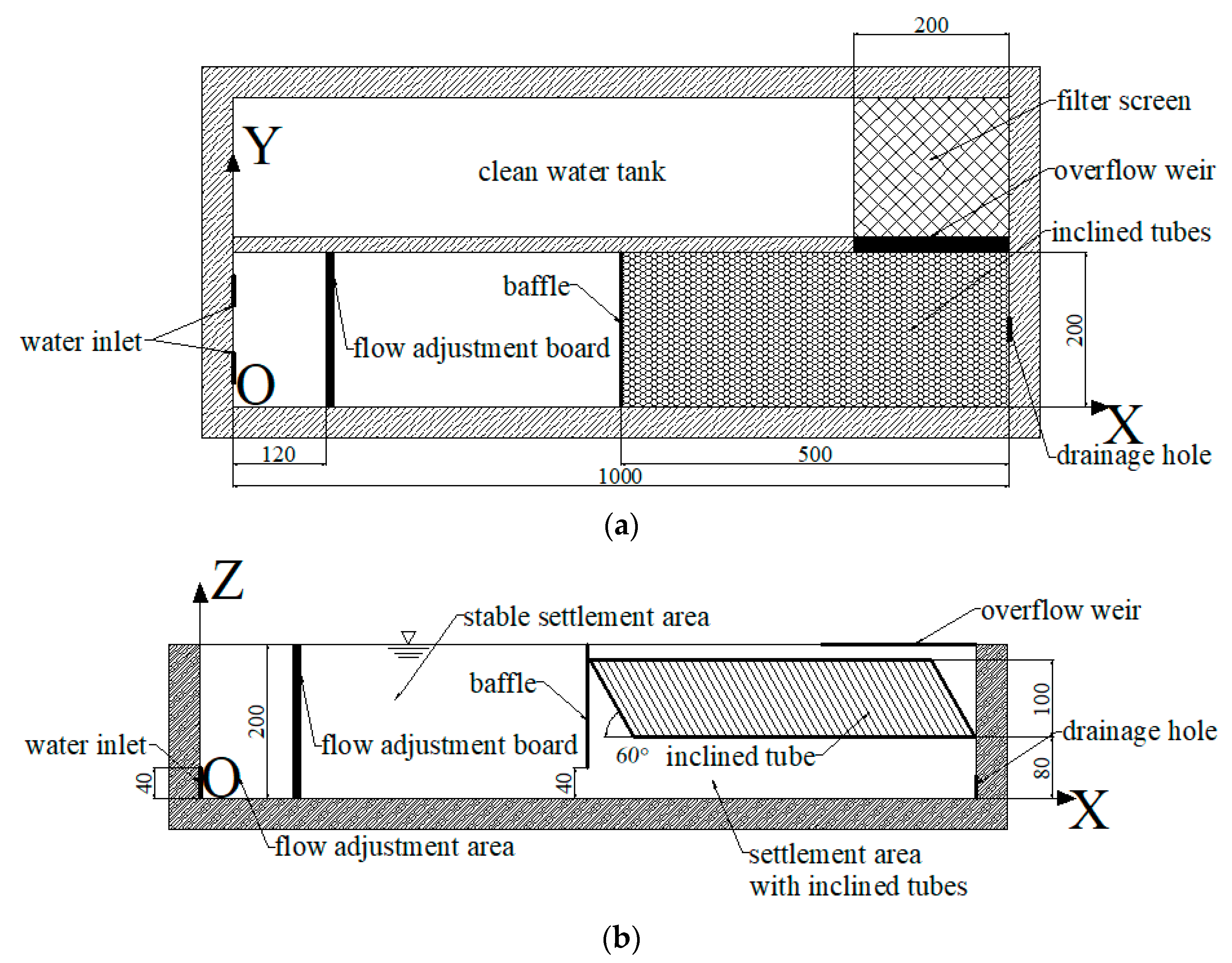
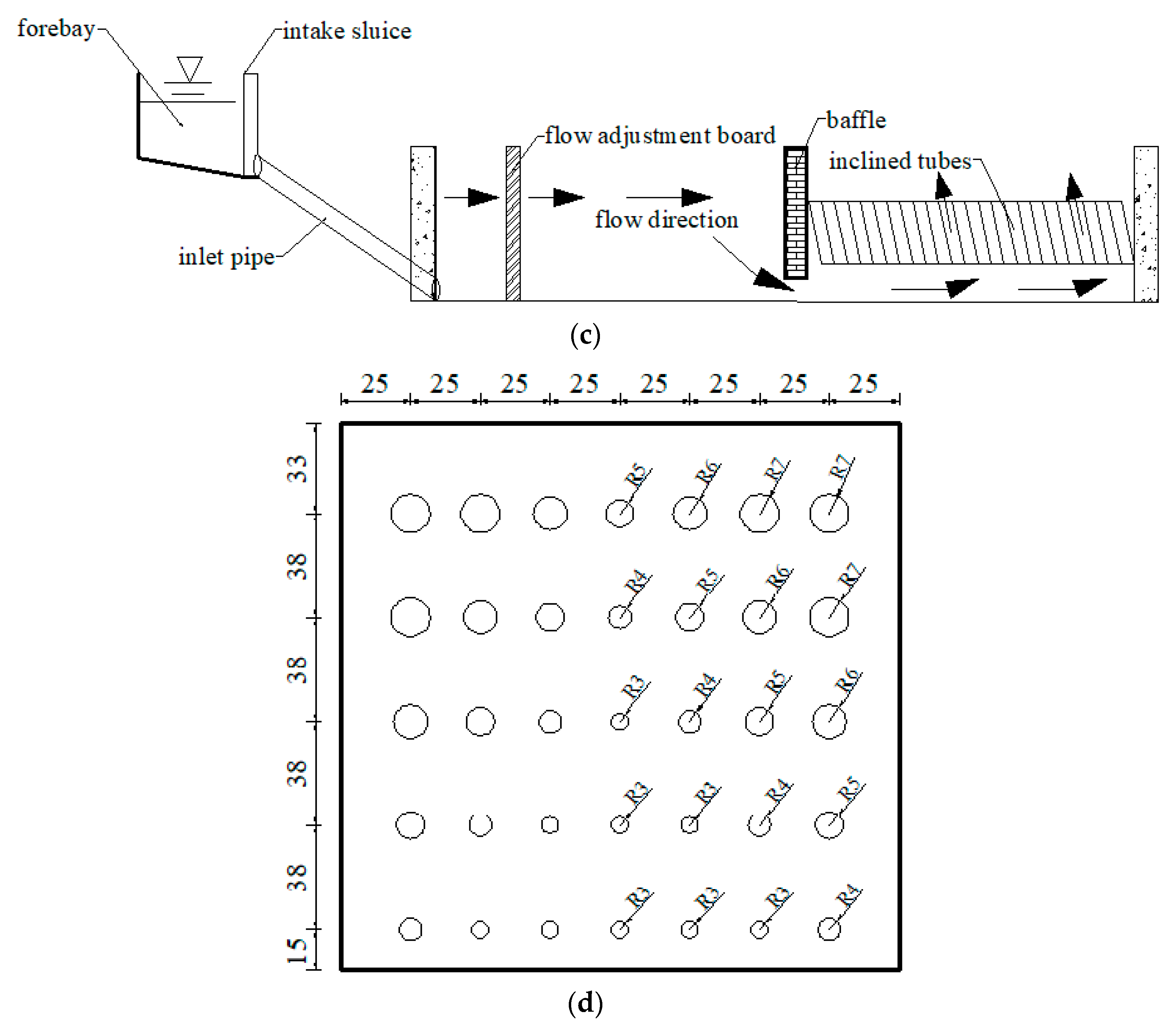
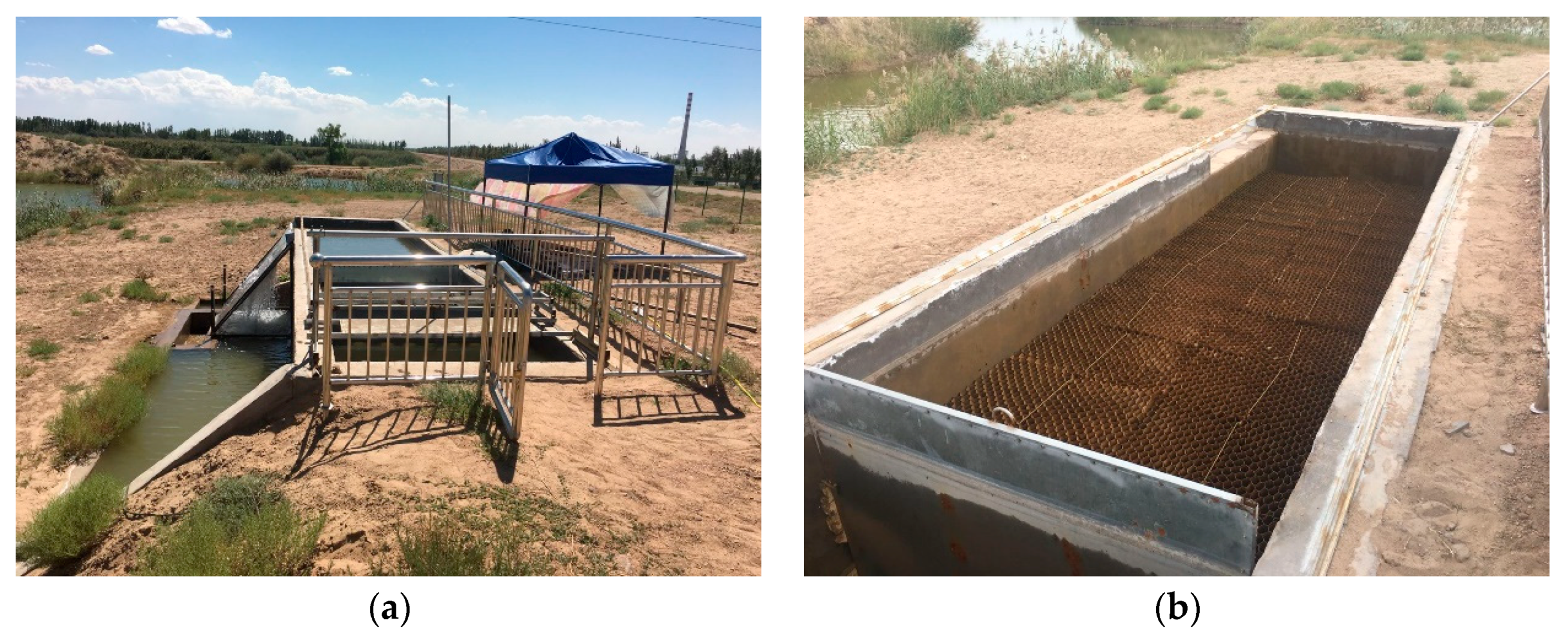


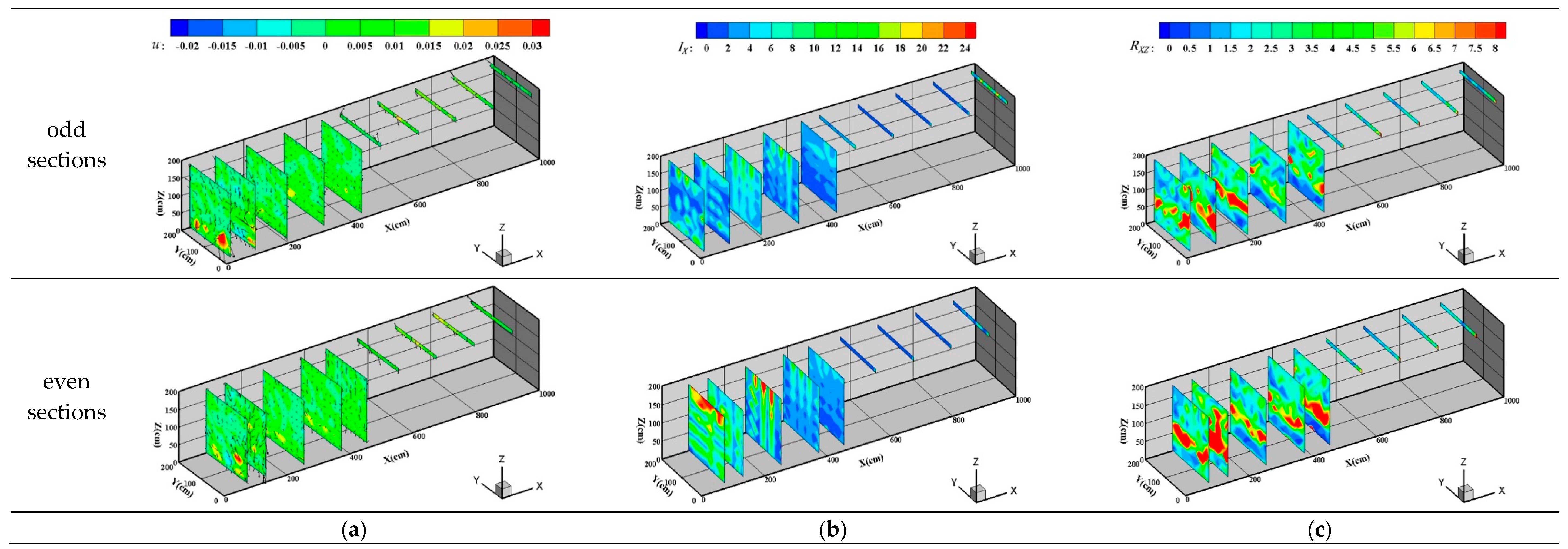

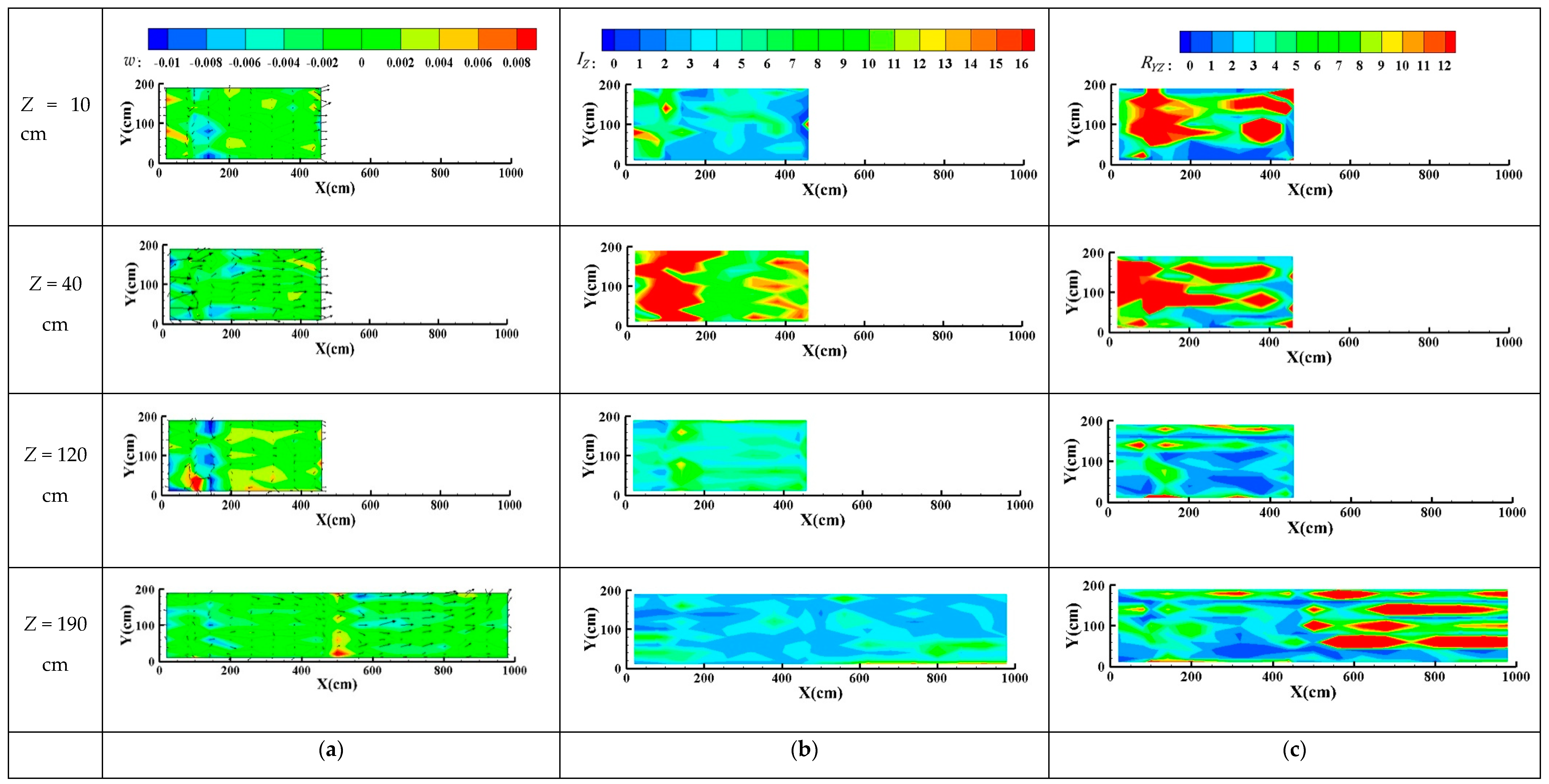
© 2020 by the authors. Licensee MDPI, Basel, Switzerland. This article is an open access article distributed under the terms and conditions of the Creative Commons Attribution (CC BY) license (http://creativecommons.org/licenses/by/4.0/).
Share and Cite
Wang, K.; Li, Y.; Ren, S.; Yang, P. Prototype Observation of Flow Characteristics in an Inclined-Tube Settling Tank for Fine Sandy Water Treatment. Appl. Sci. 2020, 10, 3586. https://doi.org/10.3390/app10103586
Wang K, Li Y, Ren S, Yang P. Prototype Observation of Flow Characteristics in an Inclined-Tube Settling Tank for Fine Sandy Water Treatment. Applied Sciences. 2020; 10(10):3586. https://doi.org/10.3390/app10103586
Chicago/Turabian StyleWang, Keyuan, Yunkai Li, Shumei Ren, and Peiling Yang. 2020. "Prototype Observation of Flow Characteristics in an Inclined-Tube Settling Tank for Fine Sandy Water Treatment" Applied Sciences 10, no. 10: 3586. https://doi.org/10.3390/app10103586
APA StyleWang, K., Li, Y., Ren, S., & Yang, P. (2020). Prototype Observation of Flow Characteristics in an Inclined-Tube Settling Tank for Fine Sandy Water Treatment. Applied Sciences, 10(10), 3586. https://doi.org/10.3390/app10103586





